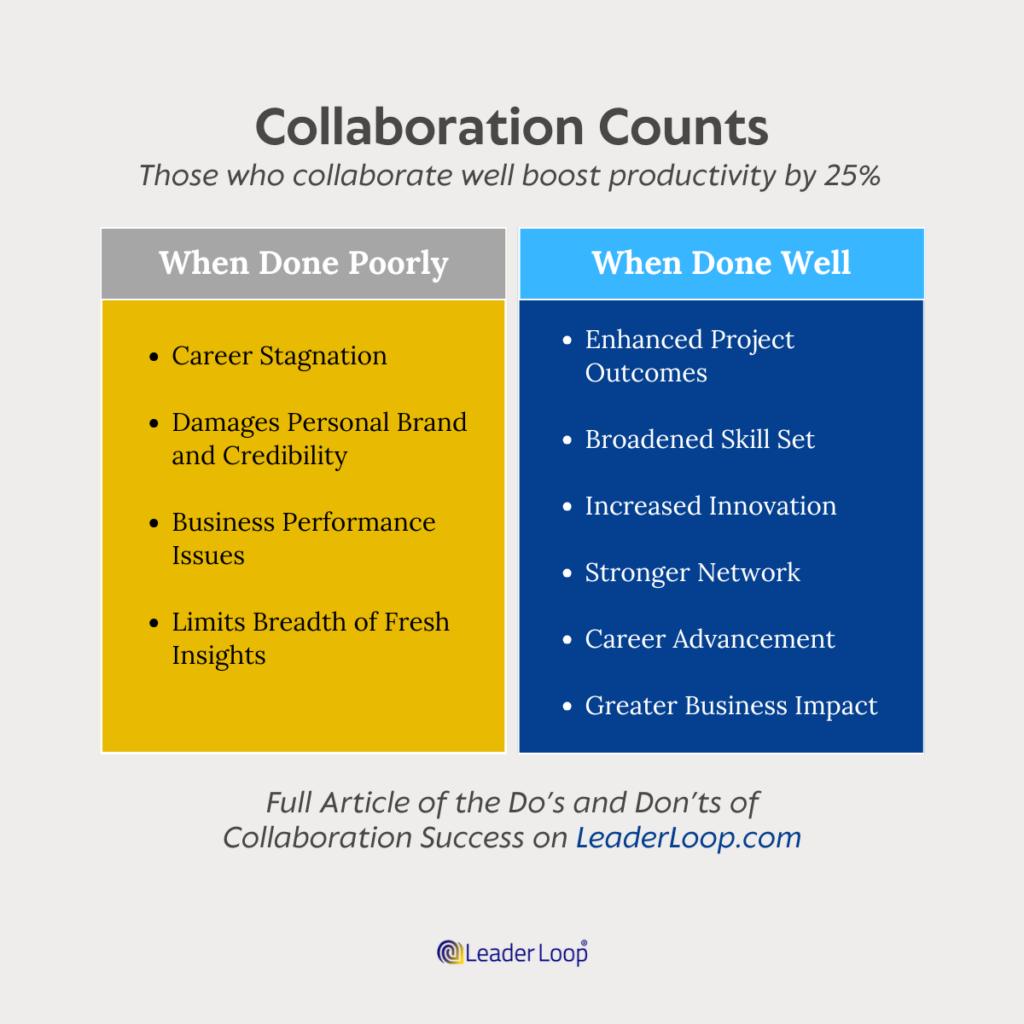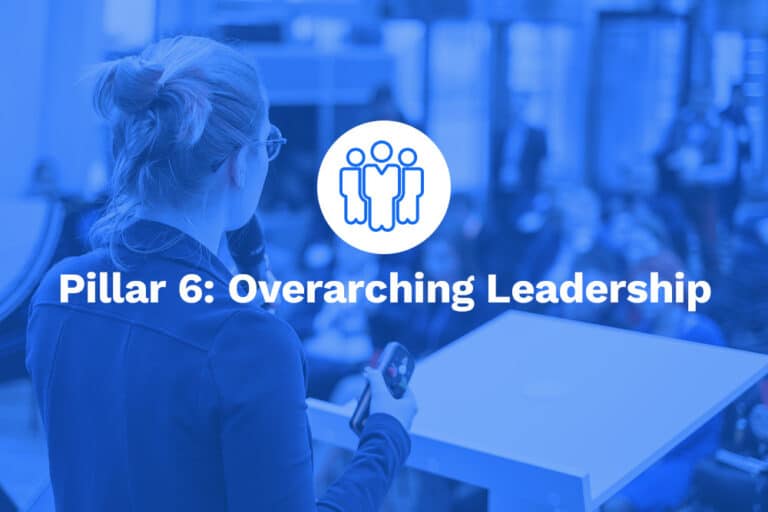Collaboration Counts: The Do’s and Don’ts for Success
Cross-functional collaboration isn’t just a nice-to-have—it’s essential. According to a study by McKinsey, teams that work well across functions can boost productivity by up to 25%. Being able to work effectively across different departments and teams can significantly boost your career and drive impactful results for your organization. At Leader Loop, we emphasize the importance of cross-functional collaboration across all stages of our Leader Loop Pillars. This article will explore what cross-functional collaboration is, the challenges & common pitfalls, best practices, and the benefits of mastering this competency.
What is Cross-Functional Collaboration?
Cross-functional collaboration involves working with people from various departments or areas of expertise to achieve a common goal. This could mean collaborating with marketing, finance, HR, IT, and other departments to complete projects, solve problems, or innovate new solutions. Effective cross-functional collaboration leverages the diverse skills, perspectives, and insights of different teams to drive success.
Why Cross-Functional Collaboration is Challenging
Working across functions can be tough due to differences in priorities, communication styles, and organizational silos. Common challenges include:
- Lack of Clarity: Without clear, shared goals, cross-functional teams can struggle to stay aligned and focused. This can lead to confusion and frustration, making it difficult to achieve project objectives. A survey by Harvard Business Review found that 70% of employees report that they lack clarity in their roles, which can hinder collaboration efforts.
- Communication Breakdowns: Different departments often have their own jargon and communication styles, which can lead to misunderstandings. Poor communication can result in wasted time, duplicated efforts, and missed deadlines. In fact, companies that excel at communication are 3.5 times more likely to outperform their peers.
- Competing Priorities: Each department may have its own priorities, which can create conflicts. When teams prioritize their own goals over the collective mission, it can erode trust and cooperation among members, leading to a toxic work environment.
- Resistance to Change: Team members may be resistant to new ways of working or collaborating with unfamiliar departments. This resistance can stifle innovation and limit opportunities for personal and organizational growth. Research indicates that organizations that fail to adapt to change can lose up to 25% of their market share within a few years.
- Poor Relationship Building: Without strong relationships, it can be hard to gain trust and cooperation from other departments. This lack of collaboration can result in missed opportunities for synergy, negatively affecting both individual reputations and the overall success of the organization. A study by Gallup found that employees who feel they have strong relationships at work are 12 times more likely to be engaged.
Impact When Not Done Right
Failing to effectively collaborate across functions can have significant negative consequences:
- Career Stagnation: Poor collaboration can limit your visibility and opportunities within the organization. If you’re not seen as a team player, it may hinder your chances of promotions and career advancement. Research shows that employees with strong collaboration skills are more likely to be recognized as leaders, enhancing their professional reputation.
- Damage to Personal Brand: Ineffective collaboration can tarnish your personal brand. Colleagues may view you as uncooperative or difficult to work with, which can lead to a negative reputation that’s hard to shake. In today’s workplace, where networking and relationships are crucial, a damaged personal brand can limit future opportunities.
- Business Performance Issues: On a larger scale, lack of collaboration can lead to inefficiencies and decreased productivity. A study by the Institute for Corporate Productivity found that organizations with effective collaboration practices were 5 times more likely to achieve high performance and financial success. When teams fail to collaborate, it can result in project delays, budget overruns, and ultimately impact the bottom line.
Best Practices for Cross-Functional Collaboration
- Establish Clear Goals and Roles: Define the project’s goals and each team member’s role and responsibilities clearly. This ensures everyone is on the same page and knows what is expected.
- Communicate Effectively: Use clear and consistent communication to keep everyone informed and aligned. Regular updates and check-ins can help prevent misunderstandings and keep the project on track.
- Build Strong Relationships: Take the time to build relationships with team members from other departments. This builds trust and makes collaboration smoother and more effective.
- Foster a Collaborative Culture: Encourage a culture where collaboration is valued and rewarded. Recognize and celebrate successful cross-functional efforts.
- Leverage Technology: Use collaboration tools and platforms to facilitate communication and project management. Tools like Slack, Trello, and Microsoft Teams can help keep everyone connected and organized.
- Be Open and Flexible: Stay open to new ideas and be willing to adapt your approach as needed. Flexibility is key to successful collaboration.
Cross-Functional Collaboration Across Career Stages
- Early Career Stage: At this stage, you may participate in project teams or task forces that involve multiple departments. Your focus will be on learning how to work with different teams and understanding their roles. Key initiatives might include assisting with product launches or contributing to marketing campaigns, allowing you to build foundational collaboration skills.
- Mid Career Stage: As you progress, your involvement in cross-functional collaboration becomes more proactive. You might lead small projects requiring input from various departments, such as process improvement initiatives or cross-departmental training programs. This stage is about enhancing your leadership capabilities while driving meaningful outcomes through collaboration.
- Senior Career Stage: At the senior level, you are expected to lead significant projects and initiatives that span multiple departments. This could involve strategic planning sessions, large-scale process overhauls, or significant product developments. Your ability to integrate diverse perspectives and drive collaborative success is critical, as is mentoring less experienced colleagues in effective collaboration practices.
What It Unlocks When Done Well
- Enhanced Project Outcomes: Cross-functional collaboration brings diverse skills and perspectives to the table, leading to more innovative and effective solutions. Projects are completed more efficiently and to a higher standard.
- Broadened Skill Set: Working with different departments helps you develop a broader range of skills and knowledge. This versatility is highly valuable and can set you apart in your career.
- Increased Innovation: Combining insights from various functions fosters creativity and innovation. You’ll be better equipped to tackle complex problems and drive new initiatives.
- Stronger Network: Building relationships across departments expands your professional network. A strong network is crucial for career growth and can open up new opportunities.
- Career Advancement: Demonstrating your ability to collaborate across functions shows that you’re a strategic thinker and a team player. This can lead to promotions and leadership opportunities.
- Greater Impact: By leveraging the strengths of different teams, you can drive more impactful results for your organization. This not only benefits your company but also enhances your reputation as a high-performing leader.
The Gist
Mastering cross-functional collaboration is essential for career advancement and achieving impactful results at work. By establishing clear goals, communicating effectively, building strong relationships, and fostering a collaborative culture, you can navigate the challenges of cross-functional work and unlock its many benefits. At Leader Loop, we have seen how effective cross-functional collaboration drives innovation, efficiency, and success at all stages of the Leader Loop Pillars. By embracing this competency, you will not only enhance your leadership capabilities but also contribute significantly to your organization’s success and your own professional growth.
Sources
- Catmull, E., & Wallace, A. (2014). Creativity, Inc.: Overcoming the Unseen Forces That Stand in the Way of True Inspiration. Random House.
- Hansen, M.T. (2009). Collaboration: How Leaders Avoid the Traps, Build Common Ground, and Reap Big Results. Harvard Business Review Press.
- Harvard Business Review (2015). The Secrets of Great Teamwork. HBR Website.
- McKinsey & Company (2019). The New Collaboratives: How Cross-Functional Teams Are Building the Future. McKinsey Website.
- Institute for Corporate Productivity (i4cp) study on collaboration.
- Gallup (2020). State of the Workplace report.
Quote: “Coming together is a beginning, staying together is progress, and working together is success.” – Henry Ford.

About Leader Loop: Leader Loop crafts actionable, competency-focused articles to accelerate your career growth. Our expert-written content provides practical strategies for leadership, team management, and professional development. Whether you’re a seasoned manager or an ambitious individual contributor, our articles deliver the insights you need to excel in today’s workplace.




